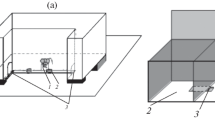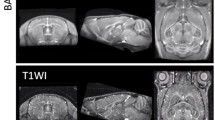Abstract
Body size (weight) and brain size were measured in inbred and hybrid mice of three different ages (1, 3, and 5 months). Hybrid values were generally greater than those of either inbred parent for both characters at all three ages (overdominance). There was statistically significant positive heterosis for both brain and body size, its magnitude consistently averaging slightly over 1.0 standard deviation unit. The variance in inbred groups was significantly greater than in hybrid groups (positive homeostasis) for body size at 1 month and for brain size at 3 and 5 months. Both characters differed among inbred strains, crosses, reciprocals, litters, and litter sizes, although body size exhibited more sexual dimorphism than did brain size. Heritabilities for brain size were high (0.63–0.67) and consistent in all ages studied, whereas those for body size were moderate in magnitude (0.28–0.54) and increased with age.
Similar content being viewed by others
References
Atchley, W. R. (1984). The effect of selection on brain and body size associations in rats.Genet. Res. 43:289–298.
Atchley, W. R., Riska, B., Kohn, L. A., Plummer, A. A., and Rutledge, J. J. (1984). A quantitative genetic analysis of brain and body size associations, their origin and ontogeny: Data from mice.Evolution 38:1165–1179.
Count, E. W. (1947). Brain and body weight in man: Their antecedents in growth and evolution.Ann. N. Y. Acad. Sci. 46:993–1122.
Dixon, W. J. (1981).BMDP Statistical Software, University of California Press, Berkeley.
Falconer, D. S. (1981).Introduction to Quantitative Genetics, Longman, New York.
Fuller, J. L., and Herman, B. (1974). Effect of genotype and practice upon behavioral development in mice.Dev. Psychobiol. 7:21–30.
Hahn, M. E., and Haber, S. B. (1978). A diallel analysis of brain and body weight in male inbred laboratory mice (Mus musculus).Behav. Genet. 8:251–260.
Hahn, M. E., Haber, S. B., and Fuller, J. L. (1973). Differential agonistic behavior in mice selected for brain weight.Physiol. Behav. 10:759–762.
Henderson, N. D. (1970). Brain weight increases resulting from environmental enrichment: A directional dominance in mice.Science 169:766–778.
Henderson, N. D. (1973). Brain weight changes resulting from enriched rearing conditions: A diallel cross analysis.Dev. Psychobiol. 6:367–376.
Herbert, J. G., Kidwell, J. F., and Chase, H. B. (1979). The inheritance of growth and form in the mouse. IV. Changes in the variance components of weight, tail length and tail width during growth.Growth 43:36–46.
Kobayashi, T. (1963): Brain-to-body ratios and time of maturation of the mouse brain.Am. J. Physiol. 204:343–346.
Lande, R. (1979). Quantitative genetic analysis of multivariate evolution, applied to brain: body size allometry.Evolution 33:402–416.
Leamy, L. (1982a). Morphometric studies in inbred and hybrid house mice. I. Patterns in the mean values.J. Hered. 73:171–176.
Leamy, L. (1982b). Morphometric studies in inbred and hybrid house mice. II. Patterns in the variances.J. Hered. 73:267–272.
Leamy, L. (1984). Morphometric studies in inbred and hybrid house mice. V. Directional and fluctuating asymmetry.Am. Nat. 123:579–593.
Leamy, L., and Thorpe, R. S. (1984). Morphometric studies in inbred and hybrid house mice. Heterosis, homeostasis and heritability of size and shape.Biol. J. Linn. Soc. 22:233–241.
Mikuni, P. A., and Nash, D. J. (1979). Ontogeny of behavior in mice selected for large size.Behav. Genet. 9:227–232.
Nash, D. J., and Kidwell, J. F. (1973). A genetic analysis of lifespan, fecundity, and weight in the mouse.J. Hered. 64:87–90.
Riska, B., Atchley, W. R., and Rutledge, J. J. (1984). A genetic analysis of targeted growth in mice.Genetics 107:79–101.
Roderick, T. H., Wimer, R. E., Wimer, C. C., and Schwartzkroin, P. A. (1973). Genetic and phenotypic variation in weight of brain and spinal cord between inbred strains of mice.Brain Res. 64:345–353.
Roderick, T. H., Wimer, R. E., and Wimer, C. C. (1976). Genetic manipulation of neuroanatomical traits. In Petrinovich, L., and McGaugh, J. L. (eds.),Knowing, Thinking and Believing, Plenum Press, New York.
Sokal, R. R., and Rohlf, F. J. (1981).Biometry, Freeman, San Francisco.
Thorpe, R. S., and Leamy, L. (1984). Morphometric studies in inbred and hybrid house mice (Mus sp.): Multivariate analysis of size and shape.J. Zool. 199:421–432.
Author information
Authors and Affiliations
Additional information
This research was supported in part by a grant from the University Research Committee, California State University, Long Beach.
Rights and permissions
About this article
Cite this article
Leamy, L. Morphometric studies in inbred and hybrid house mice. VI. A genetical analysis of brain and body size. Behav Genet 15, 251–263 (1985). https://doi.org/10.1007/BF01065981
Received:
Accepted:
Issue Date:
DOI: https://doi.org/10.1007/BF01065981




